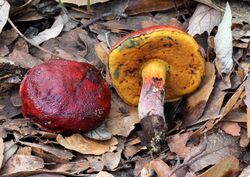Biology:Rubroboletus dupainii
| Rubroboletus dupainii | |
|---|---|

| |
| Scientific classification | |
| Domain: | Eukaryota |
| Kingdom: | Fungi |
| Division: | Basidiomycota |
| Class: | Agaricomycetes |
| Order: | Boletales |
| Family: | Boletaceae |
| Genus: | Rubroboletus |
| Species: | R. dupainii
|
| Binomial name | |
| Rubroboletus dupainii (Boud.) Kuan Zhao & Zhu L.Yang (2014)
| |
| Synonyms[2] | |
| |
Rubroboletus dupainii, commonly known as Dupain's bolete, is a bolete fungus of the genus Rubroboletus. It is native to Europe, where it is threatened, and red listed in six countries.[3] It also occurs in North America, although it is rare there.[4] It was first recorded from North Carolina, and then from Iowa in 2009.[5] It was reported from Belize in 2007, growing under Quercus peduncularis and other oaks.[6]
The bolete was first described scientifically by French mycologist Jean Louis Émile Boudier in 1902.[7] It was transferred to the new genus Rubroboletus in 2014 along with several other allied reddish colored, blue-staining bolete species.[8] Phylogenetically, R. dupainii is the sister species of Rubroboletus lupinus.[9]
See also
References
- ↑ Maire R. (1937). "Fungi Catalaunici: Series altera. Contributions a l'étude de la flore mycologique de la Catalogne" (in French). Publicacions del Instituto Botánico Barcelona 3 (4): 46.
- ↑ "GSD Species Synonymy: Rubroboletus dupainii (Boud.) Kuan Zhao & Zhu L. Yang". Species Fungorum. CAB International. http://www.speciesfungorum.org/GSD/GSDspecies.asp?RecordID=809237. Retrieved 2015-06-20.
- ↑ The 33 Threatened Fungi in Europe. Council of Europe. 2006. p. 40. ISBN 978-92-871-5928-1. https://books.google.com/books?id=6mAfxSiGB9MC&pg=PA40.
- ↑ Mushrooms of the Southeastern United States. Syracuse, New York: Syracuse University Press. 2007. p. 213. ISBN 978-0-8156-3112-5. https://books.google.com/books?id=IB1Gv3jZMmAC&pg=PA213.
- ↑ Both EE. (2009). "The second record of the European species, Boletus dupainii, in North America". Bulletin of the Buffalo Society of Natural Sciences 38: 1–4. Archived from the original on 2010-03-31. https://web.archive.org/web/20100331105830/http://www.timberhilloaksavanna.com/SecondRecordofEuropeanSpecies.pdf.
- ↑ "Boletes from Belize and the Dominican Republic". Fungal Diversity 27: 247–416. 2007. http://www.nrs.fs.fed.us/pubs/jrnl/2007/nrs_2007_ortiz-santana_001.pdf.

- ↑ Boudier JLÉ. (1902). "Champignons nouveaux de France" (in French). Bulletin de la Société Mycologique de France 18: 137–46. https://www.biodiversitylibrary.org/page/34217690.
- ↑ "A new genus, Rubroboletus, to accommodate Boletus sinicus and its allies". Phytotaxa 188 (2): 61–77. doi:10.11646/phytotaxa.188.2.1.
- ↑ "Present status and future of boletoid fungi (Boletaceae) on the island of Cyprus: cryptic and threatened diversity unraveled by 10-year study.". Fungal Ecology 41 (13): 65–81. 2019. doi:10.1016/j.funeco.2019.03.008.
External links
Wikidata ☰ {{{from}}} entry
 |

